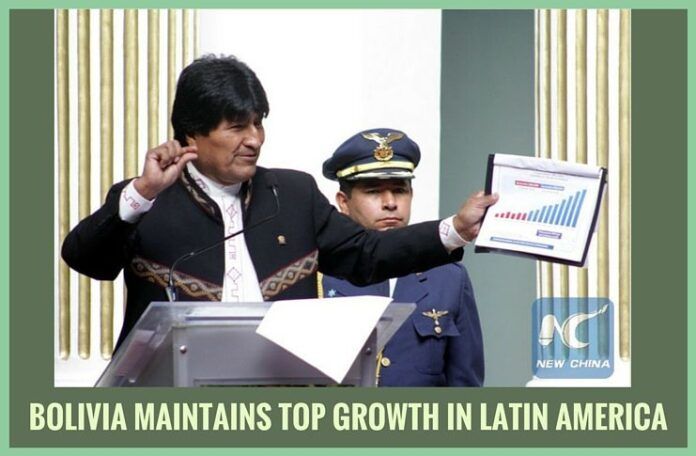
Despite commodity price falls Bolivia maintains top growth in S. America
[dropcap color=”#008040″ boxed=”yes” boxed_radius=”8px” class=”” id=””]B[/dropcap]olivia appears to have been spared the worst effects of a fall in international commodity prices as it announced economic growth of 4.9 percent in the first four months of the year.
The figure was published in a report by Bolivia’s National Institute of Statistics (INE), which said that Bolivia remained the fastest growing economy in South America.
Mario Guillen, Bolivia’s deputy minister of pensions, told Xinhua that this sees Bolivia lead regional growth for the third year in a row, thanks to the economic policies implemented by President Evo Morales since 2006.
” Guillen said Bolivia has been able to ensure its growth not dependent on international commodity prices, by promoting dynamic domestic consumption and public investment.
According to Oscar Heredia, an economic analyst from the Higher University of San Andres in La Paz, Bolivia is also running counter to predictions of economic contraction in the region.
[dropcap color=”#008040″ boxed=”yes” boxed_radius=”8px” class=”” id=””]T[/dropcap]he International Monetary Fund expects Latin America to register a negative growth of 0.5 percent in 2016 while the World Bank is more pessimistic, projecting a drop of 1.3 percent.
“These international organizations, beyond having negative projections, also predicted that Bolivia’s growth would be the best in the region for the third year in a row,” said Heredia.
PUBLIC INVESTMENT
Planning Minister Rene Orellana told Xinhua that public investment remains the economy’s major drive and would still be for the period 2015-2020.
According to Orellana, the government’s broad investment plans are backed by over 13 billion U.S. dollars in foreign reserves, foreign investment and private investment from within Bolivia.
“The economic model of the last 10 years has been translated into savings for foreign reserves…and positive ratings that allow us to seek credit,” added the minister.
By 2020, Bolivia is expected to invest 48 billion dollars as part of its National Development Plan, while the government believes that foreign direct investment for 2015-2020 will also reach 57 billion dollars.
” We have calculated exactly how much we will borrow by 2020. This includes over 7 billion dollars from China, which will go towards building light railways in Cochabamba and Santa Cruz, as well as in hospitals,” explained Orellana.
Furthermore, the country has also inked credit agreements with the Inter-American Development Bank, the Development Bank of Latin America, the World Bank, the French Development Agency, the European Investment Bank, and the Export-Import Bank of Korea.
Orellana recognized that all these credits will be part of an ambitious investment plan, but noted that the country will manage them very carefully.
Notes:
1. Xinhua
(This story has not been edited by PGurus.com and is auto–generated from a syndicated feed we subscribe to.)
- Pentagon cancels aid to Pakistan over record on militants - September 2, 2018
- The curious case of Tamil Nadu’s opposition to NEET - September 4, 2017
- If 2.6 Billion People Go To War: India vs. China - July 22, 2017








